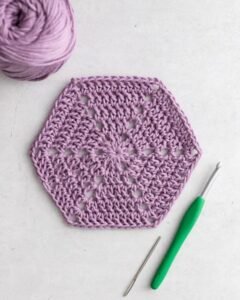Crochet hexagons are a versatile and visually appealing element in the crochet world, offering endless possibilities for blankets, scarves, pillows, and more.
Known for their six-sided shape, these beautiful patterns can range from simple and classic to intricate and colorful.
This guide dives into how to create a crochet hexagon, covering every detail and stitch required to make a flawless pattern, perfect for beginners and experienced crocheters alike.

Understanding the Beauty of Crochet Hexagons
Crochet hexagons are incredibly popular because of their modular nature, allowing crafters to connect them seamlessly into larger projects like blankets or shawls. Each crochet hexagon can be made in a single color for a minimalist look or in multiple shades to create a vibrant, eye-catching design. They are often the foundation for beautiful afghan patterns and can be joined together to form endless combinations.
The six-sided crochet design creates a stunning geometric look when joined together, giving a different aesthetic from the traditional square patterns. This unique shape is both practical and decorative, allowing you to play with color and layout for different effects. Working with hexagons also provides a great opportunity to experiment with textures and stitches, making them a fantastic project for honing your crochet skills.
In addition to their aesthetic value, crochet hexagons are a great way to use up yarn scraps from previous projects, making them an eco-friendly choice. Many crafters enjoy creating colorful hexagons from leftover yarn, resulting in unique, multicolored pieces that add a personal touch to any project.
Materials Needed for a Crochet Hexagon Pattern
To begin your crochet hexagon project, gather the necessary materials. You’ll need a medium-weight yarn, which is ideal for this pattern, along with a crochet hook size suitable for your yarn. Using the correct hook size ensures the stitches are even and the hexagon maintains its shape. Additionally, keep a pair of scissors and a tapestry needle on hand for finishing touches.
Choosing the right yarn is essential. Many crocheters prefer cotton or acrylic yarn for hexagons as they provide a sturdy structure and vibrant color options. Depending on the project’s purpose, you might opt for softer yarn for blankets or sturdier yarn for decorative items like coasters. Color choice is entirely up to you, but working with contrasting shades can enhance the geometric effect of each hexagon.
For beginners, starting with a single-color hexagon is recommended, as this allows you to focus on the stitch pattern without the complexity of color changes. Once you’re comfortable with the pattern, experimenting with multiple colors within one hexagon or joining different colored hexagons can elevate the design’s appearance.
Step-by-Step: How to Crochet a Basic Hexagon Pattern
Creating a crochet hexagon involves a series of increases and specific stitch placements to form the six-sided shape. Begin with a magic circle, which is a common technique in crochet, allowing for a tight center with no gap. Make sure your stitches are even, and follow each round carefully to maintain the shape.
Round 1: Start by creating a magic ring, and chain 3. This chain acts as your first double crochet. Add 11 more double crochet (dc) stitches into the ring, giving you a total of 12 double crochets. Join the last stitch to the beginning chain with a slip stitch to complete the round. Pull the ring tight to close the center.
Round 2: Chain 3, then double crochet into the same stitch. For each following stitch, add two double crochets (increase) until you reach the end of the round, resulting in 24 stitches. Joining each round with a slip stitch ensures that the hexagon remains flat and retains its shape.
Round 3 and Beyond: Chain 3 and work 2 double crochets into the first stitch. In the next stitch, work one double crochet. Continue alternating 2 dc and 1 dc until the round is complete, increasing the stitch count evenly in each new round. Adjust as needed based on your hexagon’s desired size.
Tips for Mastering the Crochet Hexagon Pattern
Achieving a perfect hexagon requires attention to detail with stitch placement and counts. One of the most common mistakes is losing track of increases in each round, which can lead to a misshapen hexagon. Counting stitches at the end of each round ensures your pattern stays even and symmetrical, avoiding frustration later on.
Blocking your hexagons after completion can greatly improve their appearance, especially when joining them together. Blocking helps to even out stitches and give each hexagon a uniform shape, making it easier to join multiple hexagons in a larger project. You can block your crochet pieces by dampening them and shaping them with pins, allowing them to dry in the desired shape.
Another tip is to weave in the ends as you go, especially if you’re using multiple colors. This makes the finishing process much easier and results in a cleaner look. Using a tapestry needle, weave the ends back and forth within the hexagon’s stitches to secure them neatly.
Joining Crochet Hexagons for Larger Projects
Once you’ve created multiple crochet hexagons, it’s time to join them together for a larger project. There are various techniques for joining, each providing a different finish. The most common methods are the slip stitch join, whip stitch, and continuous join-as-you-go, each offering unique visual effects and functional benefits.
The slip stitch join is popular for its clean, subtle look and is done by placing the hexagons side by side and slip-stitching through each edge stitch. This method is ideal for projects where you want the hexagons to appear seamless. The whip stitch, on the other hand, is quicker and offers a more pronounced, raised effect along the joins, which can add texture to your project.
For those looking to speed up the process, the continuous join-as-you-go method allows you to connect hexagons while crocheting the final round. This approach saves time and reduces the need for weaving in ends, making it a favorite among seasoned crocheters for blanket and afghan projects.
Advanced Variations of the Crochet Hexagon Pattern
Once you’re comfortable with the basic hexagon, try experimenting with more complex variations. Adding textures through different stitch types, such as bobble stitches or puff stitches, can bring dimension to your hexagon, creating an interesting, tactile pattern. These textured hexagons can be used to accentuate certain parts of a blanket or add depth to decorative pieces.
Another popular variation is the granny hexagon, which follows a similar pattern but incorporates chain spaces, giving it a more open, airy look. Granny hexagons are fantastic for summer blankets or shawls due to their lightweight feel. They also work well for projects that use multiple colors, as the open design allows each color to stand out.
For those interested in exploring colorwork, consider trying a flower hexagon pattern. This pattern usually starts with a flower design in the center and expands into a hexagon shape. It’s a bit more advanced but can create stunning results, especially when using vibrant colors to make the floral design pop.
Frequently Asked Questions about Crochet Hexagon Patterns
Q: What’s the best yarn to use for crochet hexagons?
A: Medium-weight yarn, such as acrylic or cotton, is ideal for crochet hexagons. These types of yarn offer durability and vibrant color options, making them great for both decorative and functional pieces.
Q: Can I adjust the size of my hexagons?
A: Yes! To increase the size, simply add more rounds, following the increase pattern established. For smaller hexagons, use fewer rounds. Adjusting hook size can also affect the hexagon’s dimensions.
Q: How do I prevent my hexagon from curling?
A: Ensuring consistent tension and correct stitch placement can help prevent curling. Additionally, blocking your finished hexagons can help them lay flat, especially if they’ll be joined into larger projects.
Final Thoughts on Mastering Crochet Hexagons
Crochet hexagons open up a world of creative opportunities, from cozy blankets to stylish accessories. By mastering the basic pattern and experimenting with variations, you can personalize each project to reflect your style and preferences. Remember, practice and attention to detail are key to creating beautiful crochet hexagons.
Experiment with colors, textures, and joining techniques to make each project unique. Whether you’re crafting a small coaster or a large afghan, crochet hexagons provide a rewarding, customizable experience that showcases the versatility and beauty of crochet.





